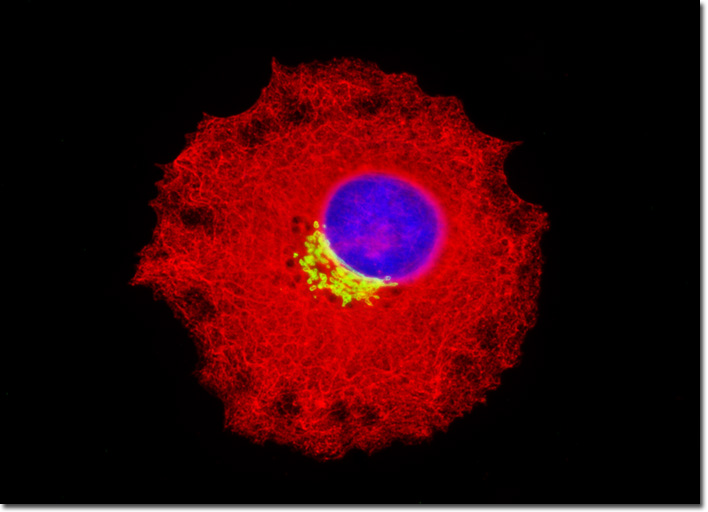Fluorescence Digital Image Gallery
Human Lung Carcinoma Cells (A-549)
|
One of the primary classes of intermediate filaments in the epidermis and many other epithelial tissues are the keratins, which are comprised of a family of water-insoluble proteins that form monofilaments. In human tissue, nineteen epithelial keratins have been resolved using two-dimensional gel electrophoresis, and these are divided into acidic (type I) and basic (type II) subfamilies, depending upon the isoelectric point of the individual proteins. Keratin filaments contain an equal mixture of type I and type II units, which initially form heterodimers that ultimately bind into tetramers to form the fundamental intermediate filament subunit. A single epithelial cell often produces multiple species of keratin filaments that can copolymerize into a single network. In order to visualize the relationship between the Golgi complex and the cytokeratin intermediate filament network, a culture of human lung carcinoma (A-549) cells (illustrated above) was immunofluorescently labeled primary anti-cytokeratin (pan) mouse monoclonal antibodies followed by goat anti-mouse Fab fragments conjugated Texas Red. Golgi bodies were simultaneously targeted with rabbit anti-giantin primary antibodies, followed by goat anti-rabbit secondaries conjugated to Oregon Green 488. Nuclei were counterstained with Hoechst 33342. Images were recorded in grayscale with a QImaging Retiga Fast-EXi camera system coupled to an Olympus BX-51 microscope equipped with bandpass emission fluorescence filter optical blocks provided by Omega Optical. During the processing stage, individual image channels were pseudocolored with RGB values corresponding to each of the fluorophore emission spectral profiles. |
© 1995-2025 by Michael W. Davidson and The Florida State University. All Rights Reserved. No images, graphics, software, scripts, or applets may be reproduced or used in any manner without permission from the copyright holders. Use of this website means you agree to all of the Legal Terms and Conditions set forth by the owners.
This website is maintained by our
|
